Sotheby's International Realty
- 138 Avenue Victor Hugo
- 75116 PARIS, France
- +33 1 40 60 50 00
Sotheby's International Realty
- 50 rue d'Auteuil
- 75016 PARIS, France
- +33 1 56 26 56 55
Sotheby's International Realty
- 82 Avenue de Wagram
- 75017 PARIS, France
- +33 1 46 22 27 27
Sotheby's International Realty
- Place Sainte Foy - 2 Rue de Chézy
- 92200 NEUILLY, France
- +33 1 41 43 06 46
Sotheby's International Realty
- Place Sainte Foy - 2 rue de Chézy
- 92200 NEUILLY, France
- +33 1 41 25 00 00
Sotheby's International Realty
- 37-39 rue de Turenne
- 75003 PARIS, France
- +33 1 48 87 14 41
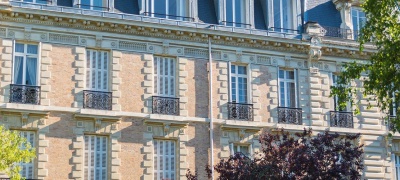
Paris 17th district - Monceau
The Monceau neighborhood, located in the 17th arrondissement of Paris, embodies the charm and prestige of the French capital. This elegant residential area is renowned for its Haussmannian architecture, peaceful streets, and refined atmosphere. Avenue de Villiers, lined with magnificent buildings and elegant mansions, is one of the main thoroughfares of this chic neighborhood.
Real estate in the Monceau neighborhood often consists of spacious and luxurious apartments, featuring high-quality finishes, noble materials, and generous interior spaces. Some mansions now house offices or embassies, further enhancing the exclusivity of the area. Real estate prices in the Monceau neighborhood reflect its prestige, with average prices per square meter ranging from €8,500 to €13,500, or even higher for the most exceptional properties.
The Monceau neighborhood thus offers a luxurious and tranquil living environment, with an exceptional quality of life in the heart of Paris.
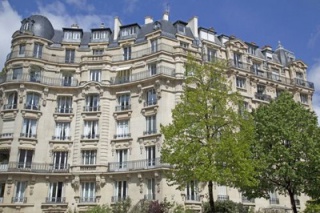
The 17th arrondissement’s Golden Triangle
The Carré d'Or neighborhood, located in the heart of the 17th arrondissement of Paris, is an elegant enclave that perfectly embodies the chic Parisian lifestyle. Bordered by Avenue de Villiers and Avenue des Ternes, two of the region's most prestigious streets, and in immediate proximity to Parc Monceau, this neighborhood stands out for its iconic Haussmannian architecture. Majestic buildings with ornate facades and wrought-iron balconies impart an ambiance that is both historic and sophisticated.
The main thoroughfares of Prony and Courcelles host a variety of upscale boutiques, art galleries, renowned restaurants, and cozy cafes, enhancing its undeniable charm.
Parc Monceau, an oasis of greenery and tranquility, is a cherished gem for residents, offering leisure and relaxation amidst Parisian splendor. Beyond its architectural heritage and green spaces, the Carré d'Or neighborhood is valued for its quality amenities, top-tier schools, and enhanced security, making it an ideal residential choice for families and professionals seeking an elegant and serene living environment.
The Carré d'Or is renowned for its luxury real estate offerings, including spacious apartments, refined townhouses, and exclusive residences, often featuring high-end finishes, designer interiors, and breathtaking views. Real estate prices in the Carré d'Or reflect its exclusivity, reaching up to €13,500 per square meter. In summary, the Carré d'Or neighborhood blends historical charm, modern luxury, and a superior quality of life, making it one of Paris's most coveted addresses for upscale living and real estate investment.
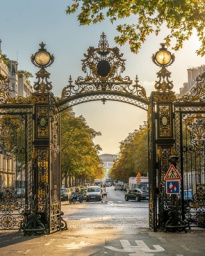
Plaine Monceau
Charming, cultural, and verdant, the Plaine-Monceau neighborhood stands out as a prestigious living area located halfway between Batignolles and Ternes. Its graceful architecture and seductive atmosphere make it one of the most sought-after neighborhoods in Paris, attracting those in search of refined living and exceptional quality of life.
Elegant and Refined Neighborhood
Plaine-Monceau is characterized by graceful architecture, blending unusual and colorful private mansions with charming houses adorned with brick and stone. These unique properties, often featuring luxurious finishes, impart the neighborhood with authentic charm and discreet elegance. Spacious interiors with antique parquet floors, moldings, and period fireplaces are typical of Plaine-Monceau’s real estate, offering sumptuous and comfortable living spaces.
Artistic and Cultural Heritage
Formerly an artists' quarter, Plaine-Monceau boasts numerous museums that delight art enthusiasts. Among them, the Jean-Jacques Henner Museum, housed in a magnificent private mansion, showcases the prolific works of the artist. This cultural heritage enriches the neighborhood and attracts a cultured and distinguished population, further enhancing the allure of luxury residences.
Ideal Living Environment
The proximity to the enchanting Parc Monceau provides residents of Plaine-Monceau with opportunities for delightful strolls in the shade of willows and the soothing sound of the stream. This emblematic park, with its lush lawns and picturesque sculptures, is a true haven of peace in the heart of the capital. The elegant Haussmannian buildings and private mansions lining the park add an additional touch of prestige to the neighborhood.
Prestigious Real Estate
Plaine-Monceau offers a varied range of prestigious real estate properties tailored to discerning buyers seeking quality residences. Here are the main types of properties available:
Luxury Apartments: Spacious and luminous apartments located in magnificent Haussmannian buildings offer refined interiors with high-quality finishes such as antique parquet floors, moldings, and fireplaces. These high-end residences feature modern and upscale amenities, ensuring optimal comfort.
Private Mansions: The neighborhood also boasts superb private mansions, often with private gardens. These prestigious properties, tastefully renovated, offer luxurious and comfortable living spaces, ideal for families and art and culture enthusiasts.
Penthouses: For those seeking panoramic views of Paris, luxurious penthouses with large terraces offer a unique perspective of the city's rooftops and iconic monuments.
Studios and Medium-sized Apartments: In addition to large properties, the neighborhood also offers studios and medium-sized apartments, perfect for singles or couples looking for an elegant pied-à-terre in a prestigious Parisian district.
Real Estate Prices
Real estate prices in the Plaine-Monceau neighborhood reflect its prestige and exclusivity, with an average price per square meter around €13,000. This price range underscores the strong demand for high-end residences in this decidedly upscale neighborhood.
In summary, Plaine-Monceau harmoniously combines architectural charm, cultural richness, and a pleasant living environment, making it one of the most sought-after and exclusive neighborhoods in Paris. The real estate offerings are diverse and cater to the varied needs and preferences of buyers seeking quality residences in a prestigious environment.
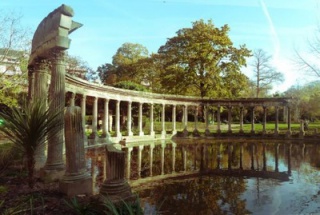
Parc Monceau
The Parc Monceau, a verdant jewel of the 17th arrondissement of Paris, captivates with its timeless beauty and tranquil atmosphere. Created in the 17th century and redesigned in the style of an English garden in the 18th century, this historic park offers an enchanting setting where elegance meets nature.
The winding paths lined with century-old trees, picturesque bridges spanning tranquil ponds, and graceful statues dotting the landscape create a romantic and refined ambiance. The park serves as a true haven of greenery in the heart of the city, providing visitors and residents alike with a refuge of calm and serenity.
Surrounded by elegant Haussmannian buildings and sumptuous residences, Parc Monceau is not only a place for relaxation and leisure but also a symbol of the Parisian art of living. Its proximity to luxury boutiques, renowned art galleries, and gourmet restaurants enhances its allure, making it a sought-after destination for both locals and visitors from around the world.
The real estate landscape around Parc Monceau features spacious apartments with panoramic views of the park, private mansions with French gardens, and townhouses with ornate facades. Real estate prices in this prestigious neighborhood reflect its high standing and attractiveness. Known for its tranquility, enhanced security, and proximity to luxury boutiques and gastronomic restaurants on Avenue Hoche and Rue de Prony, this area epitomizes Parisian chic.
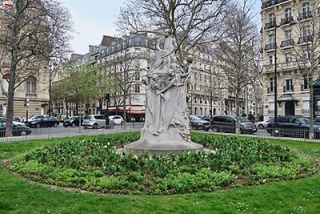
Place du Général Catroux
Elegant, historic, and distinctly prestigious, Place du Général Catroux embodies Parisian refinement in the heart of the 17th arrondissement, near Parc Monceau and Plaine-Monceau. This sought-after neighborhood captivates with its sophisticated architecture and exclusive atmosphere, appealing to an international clientele seeking an exceptional living environment in Paris.
A Historic and Prestigious Setting
Place du Général Catroux is renowned for its majestic Haussmannian buildings, showcasing Paris' rich architectural heritage. These characterful residences, often adorned with elaborate balconies and neoclassical details, offer a living environment steeped in history and distinction. Spacious interiors, renovated with noble materials and luxurious amenities, ensure absolute comfort for discerning residents.
An Urban Oasis Nearby
Proximity to Parc Monceau, a true green jewel of the capital, allows residents of Place du Général Catroux to enjoy a harmonious living environment. This magnificent park, with its English gardens, statues, and picturesque ponds, offers an ideal space for relaxation in the heart of Paris. Residences bordering this prestigious park benefit from breathtaking views and unparalleled tranquility, adding immeasurable value to this exclusive neighborhood.
Prestige and Luxury Real Estate
Place du Général Catroux offers an exquisite selection of luxury real estate tailored to the most refined tastes. Here are the main categories available:
Luxury Apartments: Spacious and luminous apartments located in the historical buildings of Place du Général Catroux offer elegant and sophisticated interiors. Featuring ancient parquet floors, high ceilings adorned with moldings, and period fireplaces, these residences epitomize Parisian luxury.
Townhouses: Sumptuous townhouses at Place du Général Catroux, often featuring private gardens, represent the pinnacle of residential luxury. Carefully renovated to preserve their historical character while integrating modern amenities, these properties offer an exclusive and intimate living space in the heart of the city.
Penthouses: Prestigious penthouses at Place du Général Catroux captivate with panoramic views of Paris. Featuring spacious terraces offering stunning perspectives of the city rooftops and iconic landmarks, these residences embody the ultimate expression of urban luxury.
Studios and Medium-sized Apartments: For those seeking an elegant pied-à-terre in an upscale Parisian neighborhood, Place du Général Catroux also offers studios and medium-sized apartments ideally located to enjoy all the pleasures of the French capital.
Real Estate Prices
Real estate prices at Place du Général Catroux reflect its exclusive status and exceptional attractiveness, with an average price per square meter among the highest in Paris, averaging around €14,500. This value underscores the strong demand for prestigious properties in this exceptional neighborhood.
In summary, Place du Général Catroux perfectly blends historical heritage, contemporary luxury, and unparalleled quality of life in Paris. Ideally situated and richly endowed with cultural and leisure facilities, it attracts the most discerning investors and buyers in search of exceptional real estate in the French capital.
A Historic Jewel: Hôtel Gaillard
Hôtel Gaillard, located at Place du Général Catroux, is a true historic gem in the heart of the 17th arrondissement of Paris. Built in the late 19th century in the neo-Renaissance style, this remarkable private mansion reflects the architectural elegance of its time. Its façades adorned with delicate sculptures and its sumptuous interiors, recently carefully restored, offer an exclusive residence for affluent residents seeking a unique lifestyle in Paris.
Hôtel Gaillard is distinguished by its spacious, lavishly decorated salons, ceilings adorned with frescoes, and large windows offering clear views of Place du Général Catroux. The adjacent private gardens, meticulously maintained and enhanced with fountains and flower beds, add a peaceful and private dimension to this exceptional property.




